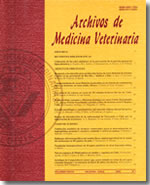Role of insectivorous bats in the transmission of Rabies in Chile
Main Article Content
Abstract
The importance of wild animals in the epidemiology of rabies in Chile was not recognized until 1985. Since then the epidemiology of rabies has been characterized by the presence of an endemic cycle in the species of the Order Chiroptera. In 1996, after 24 years without human rabies cases, a child died of the disease. The victim was infected with an antigenic variant 4 (AgV4) virus whose reservoir is the non-hematophagous bats Tadarida brasiliensis. This event emphatized the need for a better characterization of rabies selvatic cycles, their geographical distribution, and the risk factors that influence the virus transmission to humans and domestic animals in the country.
From a total of 250 isolates obtained between 1977 and 1997, 119 were reactived. These samples were antigenically characterized by the indirect inmunofluorescence technique using a panel of 8 monoclonal antibodies direct against epitopes of the viral nucleoprotein produced by the Centers of Disease Control and Prevention, Atlanta, Georgia, USA. The analysis showed that all the viruses obtained from non-hematophagous bats were AgV4 seven out of 10 canine isolates were AgV4. The other 3 canine viruses were AgV1, whose reservoir is the dog. Of the 3 bovine isolates, 2 was AgV1 and 1 AgV4. Three feline and one porcine viruses was caracterized as AgV4. It was determined that a bovine rabies case reported in 1977 and all the viruses isolated from domestic animals since 1990 were AgV4.
These results allowed to conclude that, in Chile, the non-hematophagous bats Tadarida brasiliensis was a rabies selvatic reservoir before 1985, and since then it has been the only wild reservoir know responsible for rabies sporadic cases in human and domestic animals.

